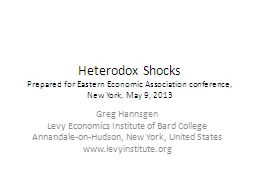

New York May 9 2013 Greg Hannsgen Levy Economics Institute of Bard College AnnandaleonHudson New York United States wwwlevyinstituteorg Views from reference works 2 nd edition Companion to Post Keynesian Economics 2012Mentions shocks only as part of exogenous approach in en ID: 647040
Download Presentation The PPT/PDF document "Heterodox Shocks Prepared for Eastern Ec..." is the property of its rightful owner. Permission is granted to download and print the materials on this web site for personal, non-commercial use only, and to display it on your personal computer provided you do not modify the materials and that you retain all copyright notices contained in the materials. By downloading content from our website, you accept the terms of this agreement.
Slide1
Heterodox ShocksPrepared for Eastern Economic Association conference,New York, May 9, 2013
Greg
Hannsgen
Levy Economics Institute of Bard College
Annandale-on-Hudson, New York, United States
www.levyinstitute.orgSlide2Slide3Slide4
Views from reference works:2nd
edition Companion to Post Keynesian Economics (2012)—Mentions shocks only as part of exogenous approach in entry on “business cycles”
New Palgrave Dictionary (1987 edition)—mentions “innovations”—time-series forecast errors—in entry for “time series.” But no separate listing for “shocks” of any kindSlide5
Idea of paper
Readers and heterodox economists
(W.C. Mitchell [1927], J.M. Keynes [1936],
H.
Minsky
[1954], M
.
Kalecki
[1956], L.
Pasinetti
[1962], G. Shackle [1973], L. Taylor [2010], W. Godley [2012], many others)
alike have benefited from the use of this tool/trope.
Looking at this topic a bit like studying our pencils or computers. They are there, but not often thought of as a subject in themselves or seriously studied.
The two types of shocks correspond broadly to (
Type 1
)
Keynes’s “changes in independent variables”
(1936) and (
Type 2
)
random simulation shocks
as in
Kalecki’s
Theory of Economic Dynamics
(1956).Slide6
Type 1 shocks (one-time impulses) have roots in Keynes’s
General Theory
Chapter 18 divides exogenous factors into “independent variables” and “given factors”
In practice, “…there is not one [factor] which is not liable to change without much warning, and sometimes substantially” (p. 249).
Example: Relatively stable but “precarious” social conventions normally undergird stock-market prices.
Sudden “crises” are a distinct dynamic phenomenon developed in Chapter 22 on the business cycle
OTHER RELEVANT SOURCES: J.M. Keynes (1937) and in G.L.S. Shackle’s
Keynesian
Kaleidics
(1973)
Often used as one-time simulation shocks, as in
this example
from Lavoie and Godley ([2006] 2012)Slide7
Type 2 heterodox shocks: randomly drawn shocks used in simulations
Stochastic error terms or parameters used throughout simulations, not just to set initial conditions
Example 1
: C.
Chiarella
, P.
Flaschel
, and R.
Franke
(2005), chapter on Keynes-Metzler-Goodwin-Taylor rule model: normally distributed shocks to aggregate demand equation.
Example 2
: W. Godley used random demand shocks in simulations of a sequence of events in posthumously published “Macroeconomics without Equilibrium or Disequilibrium” (2012). Slide8
Practical suggestions (tentative)Some forms of hybrid shocks, if you will, may be useful. Occasional shocks for simulations, a bit like regime changes
Condition expected size or rate of occurrence of shocks on prior events. Example:
Mean rate
of occurrence = f(fragility, time since last occurrence)
Size, given that crisis occurs = g(fragility, time since last occurrence, size of economy)
Consider use of
stable
(i.e., “
Lévy
-stable” or “alpha-stable”)
shocks
(potentially fat-tailed and/or skewed) when empirical work suggests that they fit.Slide9
Possible characteristics of shocks considered in sections of the paperKeynesian?
Exogenous?
Noneconomic?
Inexplicable?
Random?
Stably distributed?
Unexpected?
Symmetric?
Comparable to other heterodox
techniques?
Anomalous?
Merely expositional?
Historical?
Pragmatic?
Jumpy (discontinuous)?Slide10
Pragmatic considerationsSometimes things jump exogenously with a major effect on macro variables—how else do you model a 10-percent market correction in one day?
Shocks sometimes allow role for history—sometimes it
does
matter, even in economics
Avoid implication of complete predictability, given model and initial conditions
Not
everything
can be ascribed to deterministic causes. Yes, there are nonlinear endogenous dynamics; don’t forget them either
Often just as good as deterministic model if goal is model that can mimic properties of data series.
Use them to
s
how robustness to a skeptical publicSlide11
J. Steindl: They are there
“
My personal point of view is that the shocks are there in any case…I think it is most important keep a theory of the cycle flexible so that it will be capable of accommodating all the exogenous influences: the history, the accidents, and that a simple endogenous model cannot possibly take into
account.”
In “Reflections on
Kalecki’s
Dynamics” (1989)Slide12
Shackle: transformation in an hour or a moment
By the
kaleidic
theory I mean the view that the expectations, which together with the drive of needs or ambitions make up the ‘spring of actions’, are at all times so insubstantially founded upon data and so mutably suggested by the stream of ‘news’, that is, of counter-expected or totally unthought-of events, that they can undergo complete transformation in an hour or even a moment, as the patterns in the kaleidoscope dissolve at a
touch…
In
Keynesian
Kaleidics
(1973)Slide13
Back to outline
Source:
Approaches to Stock-flow Modeling,
Lavoie and
Zezza
, eds., New York, Palgrave Macmillan, 2012
.Slide14
Back to outline
Sources:
C.
Chiarella
,
P.
Flaschel
, and
Fr
a
nk
ë
,
Foundations for a
Disequilibrium Theory
of the Business Cycle,
Cambridge University
Press, 2005Slide15
Related imageSlide16
Back to outlineSlide17
Source:
Book authors’ webpage containing
Eviews
macros for
Monetary Economics:
An Integrated Approach to Credit, Money,
Income, Production and Wealth,
Palgrave Macmillan, 2006, 2012
http
://
gennaro.zezza.it/software/eviews/glch10.php#insout5
Back to outline